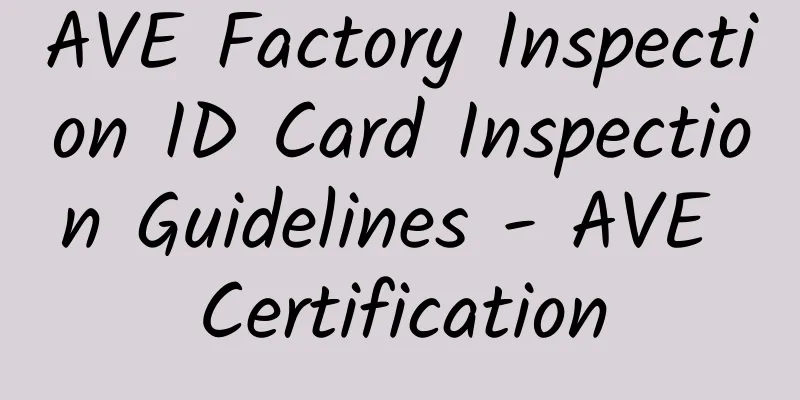AVE Factory Inspection ID Card Inspection Guidelines - AVE Certification

|
AVE Factory Inspection ID Card Inspection Guidelines 1.0 The purpose is to prevent the recruitment of underage workers or child laborers during the recruitment process, and also to prevent employees from using false certificates during their employment, which would cause losses to the company. 2.0 Scope of application/Requirements: Clerks and supervisors in charge of recruitment in the Human Resources and General Affairs Department. 3.0 Responsibilities and Authorities 3.1 Personnel and General Affairs Department Clerk 3.1.1 The clerks of the Human Resources and General Affairs Department shall arrange recruitment according to the recruitment plan and provide every applicant with an equal opportunity to compete and shall not discriminate against any job seeker. 3.1.2 The Human Resources and General Affairs Department has the right to require job applicants to provide proof of their identity for review and confirmation, and has the right to make an initial screening or rejection of job applicants. 3.1.3 For identity documents that cannot be confirmed or are in doubt, the clerk of the Human Resources and General Affairs Department should promptly report to the superior. 3.2. Head of Human Resources and General Affairs Department 3.2.1 The head of the Human Resources and General Affairs Department should instruct his/her staff on how to identify identity cards and recheck employee identity cards to identify any problems. 3.3.2 The head of the Human Resources and General Affairs Department shall verify the authenticity of the ID card upon receiving feedback from the department clerk. 4.0 Content 4.1 Since the issuance of the People's Republic of China ID card, two generations have been issued. There are three versions of the first generation ID card. The second generation ID card is in the process of being replaced and has not yet been promoted nationwide. 4.2 The first version of the first generation of ID cards was issued before July 1, 1995. The personal part of the ID card is mainly handwritten. The handwritten part is larger than the general part. There is no anti-counterfeiting mark. 4.3 The first version of the ID card has a missing “公” character on the Public Security Bureau seal, and the ID card number is 15 digits. 4.4 The second version of the first generation ID card was issued before October 1, 1999. This version overcomes the disadvantage of the first version that it has no anti-counterfeiting mark and is easy to forge. The ID card is basically all computer-printed and printed using laser holographic technology. 4.5 The second version of the ID card has the seal of the Public Security Bureau and the Chinese character "公" (public) on it, connected to the top. The anti-counterfeiting mark is the Great Wall pattern on the front of the ID card and the Chinese word "中国" and the English word "CHINA". The ID card number is still 15 digits. 4.6 The third version of the first generation ID card was issued after October 1, 1999, and the ID card number was changed to 18 digits. The anti-counterfeiting mark is basically the same as the second version. In addition to the above points, you should also pay attention to the fourth line of double helix marks in the upper right corner of the ID card, which is a single helix here. The second to last digit of the ID card number is an odd number for men and an even number for women. 4.7 The common feature of fake first generation ID cards is the intersection of the blue and red lines of the back pattern, which should be perfectly connected without the red and blue lines crossing the boundary. 4.8 The second generation of ID cards are all smart IC cards, with color printing on both sides. They have not yet been promoted nationwide, and relevant precautions are waiting for the national standards to be issued. |
>>: AVE Factory Inspection Environmental Guidelines--AVE Factory Inspection Consulting
Recommend
Otto--Germany's second largest e-commerce company
What is Otto? Otto has 9 million registered users...
What is ClickBank? What are the advantages of ClickBank?
What is ClickBank? Founded in 1998, ClickBank is ...
Update of the minimum wage standard in Guizhou Province in 2014
Update of the minimum wage standard in Guizhou Pr...
What is Tailwind? Main features of Tailwind
What is Tailwind? Tailwind is a social media trac...
Popular Science: eBay Sellers’ Entry Requirements
What are the entry requirements for eBay sellers?...
How is Yanghe Supply Chain? What are the advantages of Yanghe Supply Chain?
How about Yanghe Supply Chain? Shanghai Yanghe Su...
What is the Quanzhou Cross-border E-commerce Association? What are the requirements to join the Quanzhou Cross-border E-commerce Association?
What is Quanzhou Cross-border E-commerce Associat...
What is Taikuai Logistics? What services does Taikuai Logistics provide?
What is TaiKuai Logistics? Shenzhen Taikuai Logis...
Why is Mercari's C2C model successful?
What is Mercari? Mercari is a well-known C2C seco...
How is Xiaoxing Logistics? What services does Xiaoxing Logistics provide?
How about Xiaoxing Logistics? Xiaoxing Logistics ...
These products on eBay are very likely to infringe copyright. How can we avoid infringement of copyright on eBay?
There have been many news reports about "inf...
Knot Standard—Suit customization website
KnotStandard is a professional suit customization...
How about Rongsheng Overseas Warehouse? What are the advantages of Rongsheng Overseas Warehouse?
How about Rongsheng Overseas Warehouse? Shenzhen ...
The authoritative media CCTV2 Financial Channel fully explains what factory inspection is
With the implementation of the Global Compact, in...
FocalPrice--Focus on price
What is FocalPrice? FocalPrice was founded by Li ...









